I think I've mentioned somewhere that the 1918 SMLE I covered in the original post used to belong to my grandfather. He gave it to me quite a few years ago now, ostensibly because he wanted to thin out his collection a bit; as it turned out, he and my grandmother were preparing to go into assisted living, where such things are Not Allowed, so he wasn't thinning the collection so much as dispersing it. When that time came, a number of the others found their way to me (the Super Blackhawk, for instance, and the Universal Shotgun). The rest ended up at my father's, either for him, or earmarked for my cousins who live out of state.I mention this because back in the day, Gramp had two Lee-Enfield rifles; he gave me the .303 one, and the other one, which was in .308 Winchester/7.62×51mm NATO, went to Dad's. When Dad came up to work on the seemingly-unending bathroom remodel today (not sure how many more times we're going to be able to do that), he brought a couple of Gramp's old rifles with him, thinking I might be able to sell them and make some operating capital (not sure how I'm meant to do that under the circumstances, but anyway).

One of them was the other Lee-Enfield, and upon closer inspection it turns out to be something more interesting than I thought. Since my .303 Mk III* was a Century Arms import, I assumed that the .308 one had been rebarreled to take that cartridge by the importer. Century has kind of a track record for doing that kind of thing, and it's often not a great idea. In this case, 7.62 NATO is a higher-pressure cartridge than .303 British ever was, so a WWI-vintage SMLE action would be a pretty sketchy thing to put it in—sort of like the old importer practice of "shaving" .455 Webley cylinders to take .45 ACP. It's physically possible, but a questionable idea.
Turns out I needn't have worried, because although this rifle looks very much like an SMLE, it's a somewhat different animal.
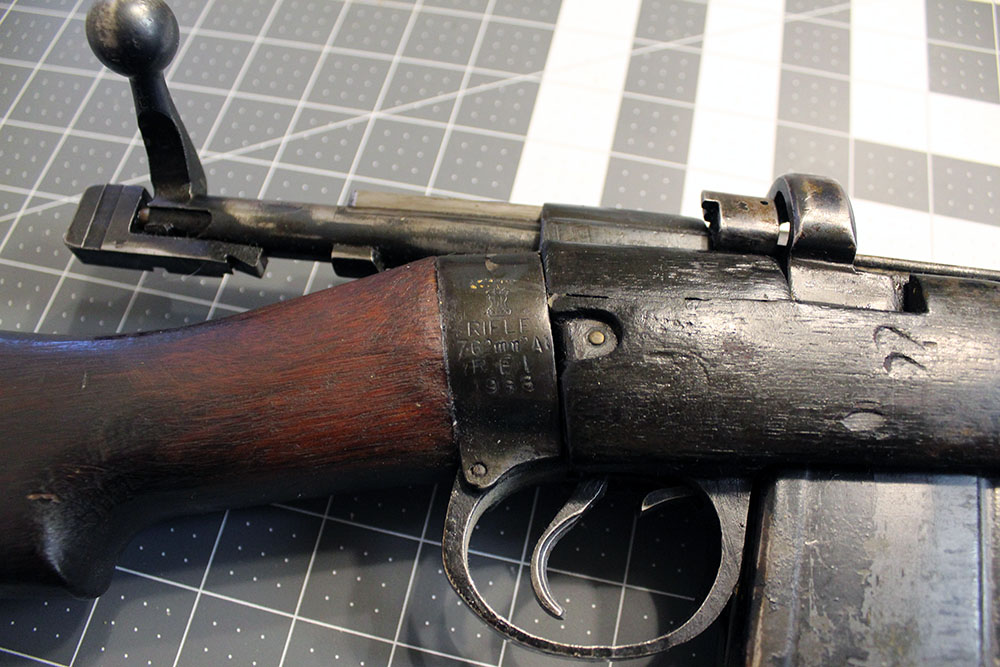
Even up close, it sure looks like an SMLE. It even has the standard wristband with model markings. But a still closer look (and a bit of twiddling with the levels in Photoshop) reveals...
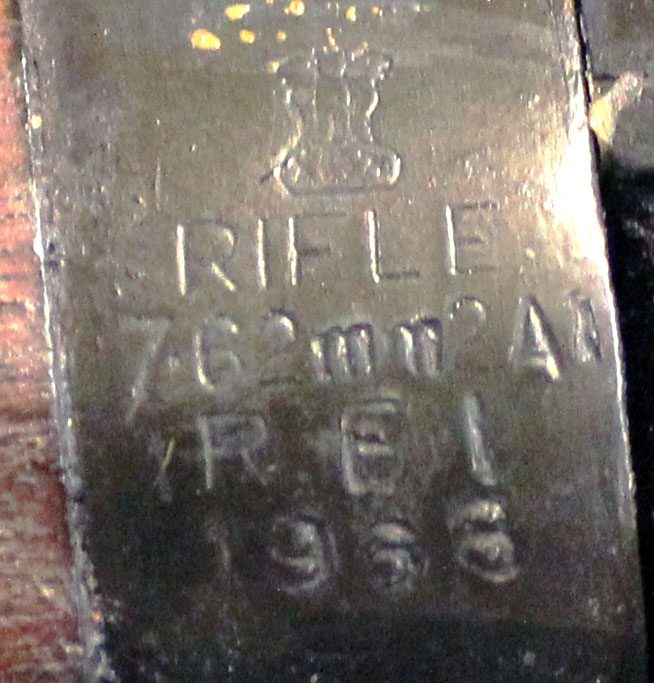
It's very much in the same pattern as the markings on British Lee-Enfield rifles, but the device surmounting it isn't the crown, it's the Lion Capital of Ashoka, which is the national emblem of the Republic of India. The text reads:
RIFLE
7.62mm 2A1
R F I
1966
(I think? That last digit might be an 8, I can't quite tell for sure.)
What we have here is a Rifle 7.62mm 2A1, made at Rifle Factory Ishapore (modern spelling Ichhapur) in West Bengal for the Indian Army, and consequently known in collector circles as the Ishapore 2A1. Although it looks virtually identical—in many ways it is virtually identical—to the British SMLE No. 1 Mk III*, vintage 1915, production of Rifle 2A began in 1963.
Post-Colonial India has something of a tradition of this kind of thing. When the British Empire controlled India, there was a great deal of British industrial investment in what was then the Empire's most important colony, and a lot of that continued after Indian independence in 1947. The Royal Enfield Bullet motorcycle, for instance, is a design from the early 1930s that was used by both British and Indian forces in World War II. In 1949, the newly independent Indian Army ordered a lot of motorcycles from Royal Enfield, so many that the company opted to build a new factory in India rather than build and ship their order from England. As is sometimes the way of these things, the British Bullet went out of production in 1962 and the British company folded five years later. Meanwhile, in Chennai, they're still building them today. When India gets hold of something that works, they don't mess with it.
Rifle Factory Ishapore was a similar story. Originally set up in the 1700s as a gunpowder factory, it was expanded to rifle production circa 1904 and made Lee-Enfields for the British Indian Army through both World Wars. For some reason, the last version of the Lee-Enfield Ishapore made was the No. 1 Mk III*; the plant never got upgraded to the No. 4 rifle that was the British standard arm in World War II. After independence, the Indian Army kept it running, and kept building SMLE Mk III*s—they had the tooling, the workers there had the skills, and the army needed every rifle it could get.
In 1960, the Indian Army—still keeping step with the British in terms of small arms—adopted Rifle 7.62mm 1A1, an Ishapore-built copy of the 7.62 NATO-chambered L1A1 Self-Loading Rifle (Britain's version of the FN FAL) as a front-line rifle. A couple of years later, Ishapore commenced production of the 2A for second-line and reserve troops, resolving the ammunition mismatch that was caused by those troops still using the .303-caliber SMLE Mk III*.
So the reason the 2A1 looks a lot like an SMLE is because it pretty much is one, made by the same people on the same tooling that had made SMLEs for years—but rather than simply rebarrel the Indian Army's existing SMLEs to 7.62 NATO, which would have been inadvisable, Ishapore produced brand-new rifles, made with more modern steel and capable of withstanding the higher-pressure NATO ammunition.
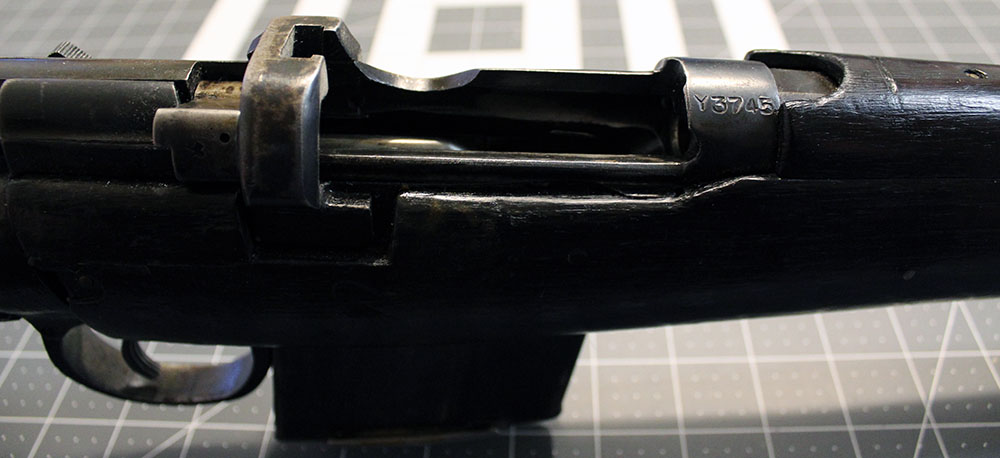
The action is essentially the same, with the same charger bridge and bolt design; the only difference in those parts is the extractor, which had to be redesigned to work with the extraction groove on the 7.62mm NATO cartridge's rimless case. Note also that the 2A1 magazine is different as well; it's longer and more squared off. They came in 10- or 12-round varieties. As noted, the rifle retains the SMLE's stripper clip bridge; I've read that they used the same five-round clips (adapted to the different cartridge), which must have been really annoying for the guys who got the 12-round magazines.
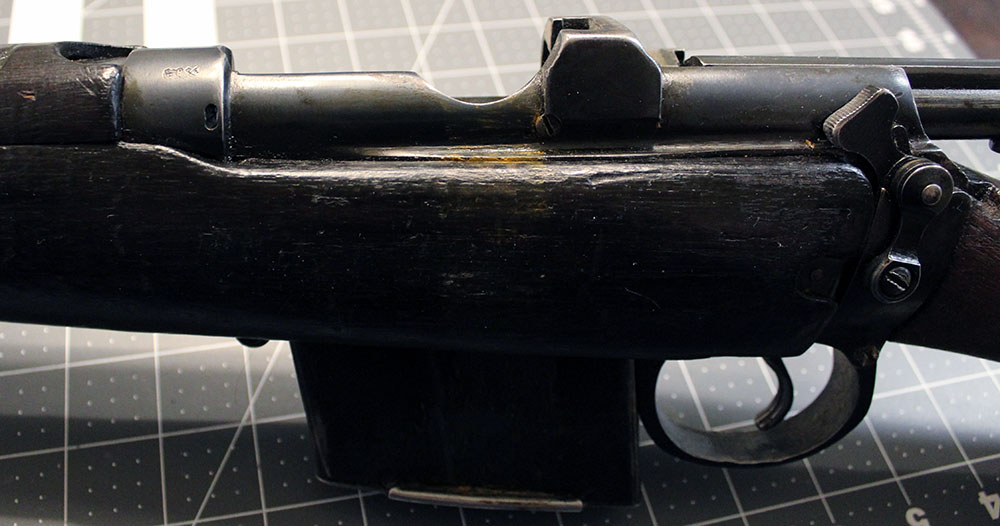
Same deal over on the left side—the classic SMLE safety lever, and no other features or markings aside from an Indian proof mark on the barrel shank.

The nose cap is also pure SMLE. It's even supposed to take the same bayonets, although my repro Pattern '03 won't quite fit this rifle:
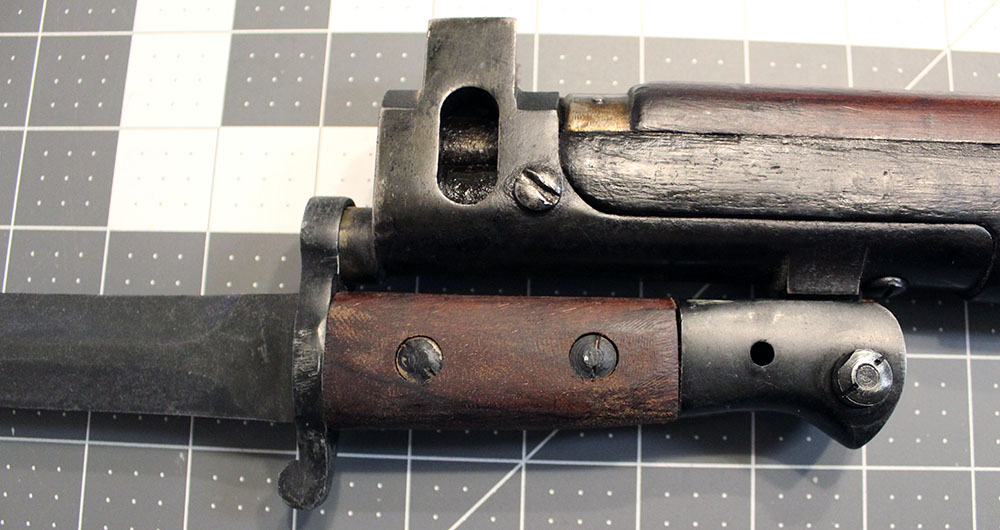
It goes on, but not willingly, and though it's very hard to pull off again because of the tight fit, it won't lock. This may be partly down to the fact that this is an inexpensive repro bayonet, although I note that it fits just fine on my 1918 SMLE.
The 2A entered production in 1963, and almost immediately left production to be replaced by the 2A1. This change didn't take long to implement, since literally the only difference between the two is the rear sight. On the 2A, they re-used the standard SMLE rear sight, with its hilariously optimistic 2,000-yard maximum range. A short way into production, someone realized how ridiculous that was and replaced it with this version:
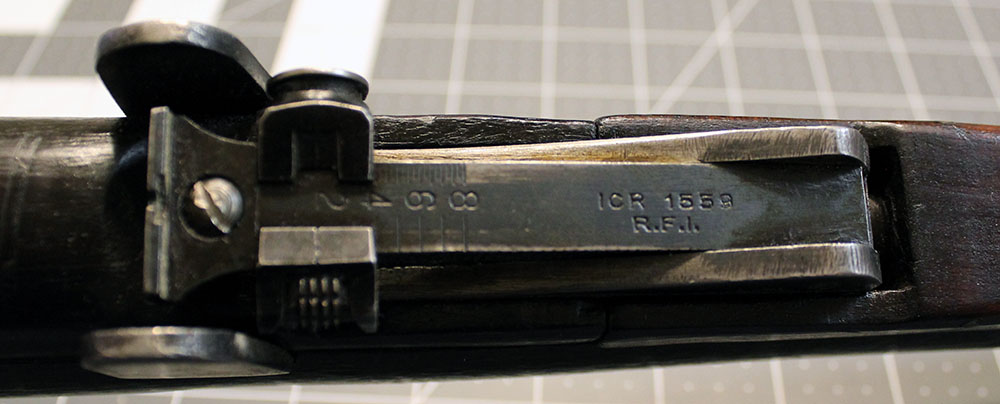
Which is exactly the same, but only calibrated out to 800 meters (India having gone metric in 1958). You can still adjust it past there, but you are entirely on your own with that nonsense, rifleman.
The only other significant point of interest on this rifle is this stamp on the stock, which presumably indicates either a unit to which it was issued or an armory rack to which it was assigned, or something along those lines.
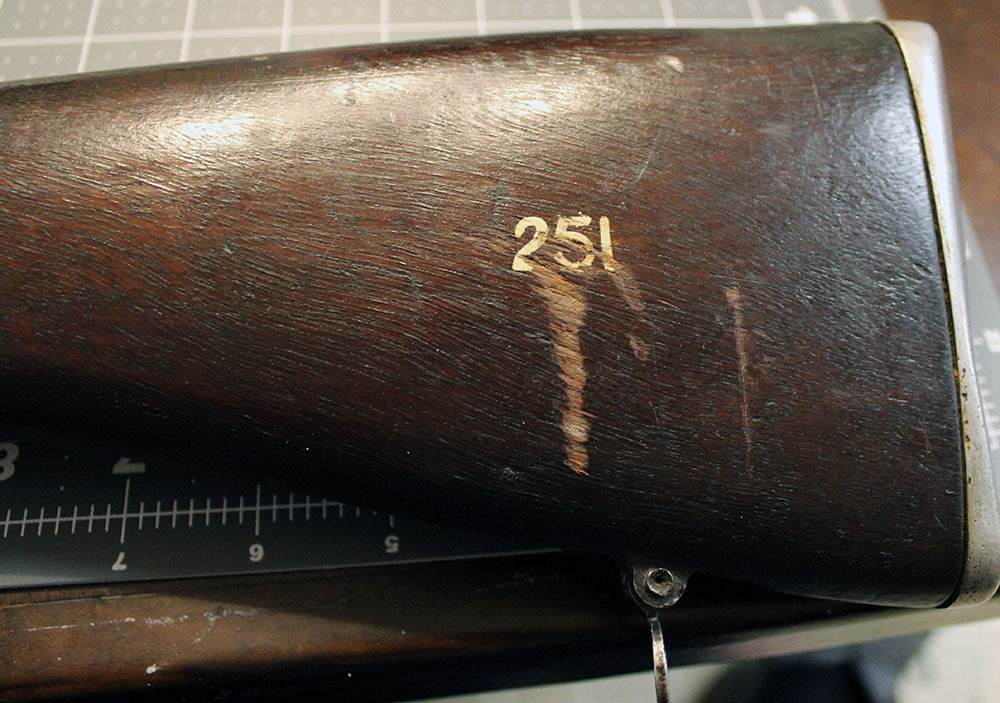
Also note the butt plate, which is aluminum, I think, rather than the brass/bronze of the WWI-vintage SMLE. That's the same butt plate they used on their Mk IIIs and, uniquely, the 1A1, Ishapore's copy of the L1A1. No other variant of the FAL, to my knowledge, was ever built with a Lee-Enfield trapdoor butt plate on a wooden stock.
(As an aside, I'd really like to do a GotW on the FAL sometime—it's a seriously interesting rifle—but they're quite expensive even in civilian semiauto guise, so that's probably going to have to wait a long while.)
So there you have it, the Ishapore 2A1: the last new-production bolt-action rifle adopted by a standing army, put into production three years after that same army adopted a modern self-loader. They made them until 1974, by which time 250,000 had been produced, and although the Indian Army no longer uses them, police agencies in the country still maintain stocks of them today.
--G.
-><-
Benjamin D. Hutchins, Co-Founder, Editor-in-Chief, & Forum Mod
Eyrie Productions, Unlimited http://www.eyrie-productions.com/
zgryphon at that email service Google has
Ceterum censeo Carthaginem esse delendam.







